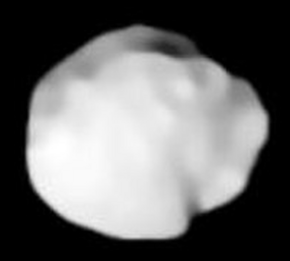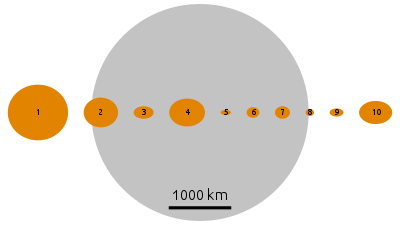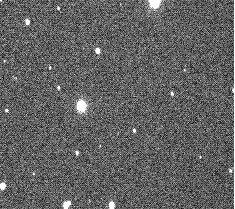3 Juno
 | |
| Discovery | |
|---|---|
| Discovered by | Karl Ludwig Harding |
| Discovery date | 1 September 1804 |
| Designations | |
| (3) Juno | |
| Pronunciation | /ˈdʒuːnoʊ/ JOO-noh[1] |
Named after | Juno (Latin: Iūno) |
| Main belt (Juno clump) | |
| Adjectives | Junonian /dʒuːˈnoʊniən/[2] |
| Symbol | |
| Orbital characteristics[3] | |
| Epoch 13 September 2023 (JD 2453300.5) | |
| Aphelion | 3.35 AU (501 million km) |
| Perihelion | 1.985 AU (297.0 million km) |
| 2.67 AU (399 million km) | |
| Eccentricity | 0.2562 |
| 4.361 yr | |
Average orbital speed | 17.93 km/s |
| 37.02° | |
| Inclination | 12.991° |
| 169.84° | |
| 2 April 2023 | |
| 247.74° | |
| Earth MOID | 1.04 AU (156 million km) |
| Proper orbital elements[4] | |
Proper semi-major axis | 2.6693661 AU |
Proper eccentricity | 0.2335060 |
Proper inclination | 13.2515192° |
Proper mean motion | 82.528181 deg / yr |
Proper orbital period | 4.36215 yr (1593.274 d) |
Precession of perihelion | 43.635655 arcsec / yr |
Precession of the ascending node | −61.222138 arcsec / yr |
| Physical characteristics | |
| Dimensions | (288 × 250 × 225) ± 5 km[5] (320 × 267 × 200) ± 6 km[6] |
| 254±2 km[5] 246.596±10.594 km[3] | |
| Mass | (2.7±0.24)×1019 kg[5] (2.86±0.46)×1019 kg[7][a] |
Mean density | 3.15±0.28 g/cm3[5] 3.20±0.56 g/cm3[7] |
Equatorial surface gravity | 0.112 m/s2 (0.0114 g0) |
Equatorial escape velocity | 0.168 km/s |
| 7.21 hr[3] (0.3004 d)[8] | |
Equatorial rotation velocity | 31.75 m/s[b] |
Pole ecliptic latitude | 27° ± 5°[9] |
Pole ecliptic longitude | 103° ± 5°[9] |
| 0.202[5] 0.238[3][10] | |
| Temperature | ~163 K max: 301 K (+28°C)[11] |
| S[3][12] | |
| 7.4[13][14] to 11.55 | |
| 5.33[3][10] | |
| 0.30" to 0.07" | |
Juno (minor-planet designation: 3 Juno) is a large asteroid in the asteroid belt. Juno was the third asteroid discovered, in 1804, by German astronomer Karl Harding.[15] It is one of the twenty largest asteroids and one of the two largest stony (S-type) asteroids, along with 15 Eunomia. It is estimated to contain 1% of the total mass of the asteroid belt.[16]
History
[edit]Discovery
[edit]Juno was discovered on 1 September 1804, by Karl Ludwig Harding.[17] It was the third asteroid found, but was initially considered to be a planet; it was reclassified as an asteroid and minor planet during the 1850s.[18]
Name and symbol
[edit]Juno is named after the mythological Juno, the highest Roman goddess. The adjectival form is Junonian (from Latin jūnōnius), with the historical final n of the name (still seen in the French form, Junon) reappearing, analogous to Pluto ~ Plutonian.[2] 'Juno' is the international name for the asteroid, subject to local variation: Italian Giunone, French Junon, Russian Юнона (Yunona), etc.[c]
The old astronomical symbol of Juno, still used in astrology, is a scepter topped by a star, ⟨![]() ⟩. There were many graphic variants with a more elaborated scepter, such as
⟩. There were many graphic variants with a more elaborated scepter, such as ![]() , sometimes tilted at an angle to provide more room for decoration.
The generic asteroid symbol of a disk with its discovery number, ⟨③⟩, was introduced in 1852 and quickly became the norm.[19][20] The scepter symbol was resurrected for astrological use in 1973.[21]
, sometimes tilted at an angle to provide more room for decoration.
The generic asteroid symbol of a disk with its discovery number, ⟨③⟩, was introduced in 1852 and quickly became the norm.[19][20] The scepter symbol was resurrected for astrological use in 1973.[21]
Characteristics
[edit]Juno is one of the larger asteroids, perhaps tenth by size and containing approximately 1% the mass of the entire asteroid belt.[22] It is the second-most-massive S-type asteroid after 15 Eunomia.[6] Even so, Juno has only 3% the mass of Ceres.[6] The orbital period of Juno is 4.36578 years.[23]
Amongst S-type asteroids, Juno is unusually reflective, which may be indicative of distinct surface properties. This high albedo explains its relatively high apparent magnitude for a small object not near the inner edge of the asteroid belt. Juno can reach +7.5 at a favourable opposition, which is brighter than Neptune or Titan, and is the reason for it being discovered before the larger asteroids Hygiea, Europa, Davida, and Interamnia. At most oppositions, however, Juno only reaches a magnitude of around +8.7[24]—only just visible with binoculars—and at smaller elongations a 3-inch (76 mm) telescope will be required to resolve it.[25] It is the main body in the Juno family.
Juno was originally considered a planet, along with 1 Ceres, 2 Pallas, and 4 Vesta.[26] In 1811, Schröter estimated Juno to be as large as 2290 km in diameter.[26] All four were reclassified as asteroids as additional asteroids were discovered. Juno's small size and irregular shape preclude it from being designated a dwarf planet.

Juno orbits at a slightly closer mean distance to the Sun than Ceres or Pallas. Its orbit is moderately inclined at around 12° to the ecliptic, but has an extreme eccentricity, greater than that of Pluto. This high eccentricity brings Juno closer to the Sun at perihelion than Vesta and further out at aphelion than Ceres. Juno had the most eccentric orbit of any known body until 33 Polyhymnia was discovered in 1854, and of asteroids over 200 km in diameter only 324 Bamberga has a more eccentric orbit.[27]
Juno rotates in a prograde direction with an axial tilt of approximately 50°.[9] The maximum temperature on the surface, directly facing the Sun, was measured at about 293 K on 2 October 2001. Taking into account the heliocentric distance at the time, this gives an estimated maximum temperature of 301 K (+28 °C) at perihelion.[11]

Spectroscopic studies of the Junonian surface permit the conclusion that Juno could be the progenitor of chondrites, a common type of stony meteorite composed of iron-bearing silicates such as olivine and pyroxene.[28] Infrared images reveal that Juno possesses an approximately 100 km-wide crater or ejecta feature, the result of a geologically young impact.[29][30]
Based on MIDAS infrared data using the Hale Telescope, an average radius of 135.7±11 was reported in 2004.[31]
Observations
[edit]Juno was the first asteroid for which an occultation was observed. It passed in front of a dim star (SAO 112328) on 19 February 1958. Since then, several occultations by Juno have been observed, the most fruitful being the occultation of SAO 115946 on 11 December 1979, which was registered by 18 observers.[32] Juno occulted the magnitude 11.3 star PPMX 9823370 on 29 July 2013,[33] and 2UCAC 30446947 on 30 July 2013.[34]
Radio signals from spacecraft in orbit around Mars and on its surface have been used to estimate the mass of Juno from the tiny perturbations induced by it onto the motion of Mars.[35] Juno's orbit appears to have changed slightly around 1839, very likely due to perturbations from a passing asteroid, whose identity has not been determined.[36]
In 1996, Juno was imaged by the Hooker Telescope at Mount Wilson Observatory at visible and near-IR wavelengths, using adaptive optics. The images spanned a whole rotation period and revealed an irregular shape and a dark albedo feature, interpreted as a fresh impact site.[30]
-
Juno seen at four wavelengths with a large crater in the dark (Hooker telescope, 2003
-
Juno moving across background stars
-
Juno during opposition in 2009
-
Video of Juno taken as part of ALMA's Long Baseline Campaign
Oppositions
[edit]Juno reaches opposition from the Sun every 15.5 months or so, with its minimum distance varying greatly depending on whether it is near perihelion or aphelion. Sequences of favorable oppositions occur every 10th opposition, i.e. just over every 13 years. The last favorable oppositions were on 1 December 2005, at a distance of 1.063 AU, magnitude 7.55, and on 17 November 2018, at a minimum distance of 1.036 AU, magnitude 7.45.[37][38] The next favorable opposition will be 30 October 2031, at a distance of 1.044 AU, magnitude 7.42.
See also
[edit]Notes
[edit]- ^ (1.44 ± 0.23)×10−11 M☉
- ^ Calculated based on the known parameters
- ^ There are two exceptions: Greek, where the name was translated to its Hellenic equivalent, Hera (3 Ήρα), as in the cases of 1 Ceres and 4 Vesta; and Chinese, where it is called the 'marriage-god(dess) star' (婚神星 hūnshénxīng). This contrasts with the goddess Juno, for which Chinese uses the transliterated Latin name (朱諾 zhūnuò).
References
[edit]- ^ "Juno". Dictionary.com Unabridged (Online). n.d.
- ^ a b "Junonian". Oxford English Dictionary (Online ed.). Oxford University Press. (Subscription or participating institution membership required.)
- ^ a b c d e f "JPL Small-Body Database Browser: 3 Juno" (2017-11-26 last obs). Archived from the original on 5 January 2016. Retrieved 17 November 2014.
- ^ "AstDyS-2 Juno Synthetic Proper Orbital Elements". Department of Mathematics, University of Pisa, Italy. Archived from the original on 9 July 2021. Retrieved 1 October 2011.
- ^ a b c d e P. Vernazza et al. (2021) VLT/SPHERE imaging survey of the largest main-belt asteroids: Final results and synthesis. Astronomy & Astrophysics 54, A56
- ^ a b c Baer, Jim (2008). "Recent Asteroid Mass Determinations". Personal Website. Archived from the original on 2 July 2013. Retrieved 3 December 2008.
- ^ a b James Baer, Steven Chesley & Robert Matson (2011) "Astrometric masses of 26 asteroids and observations on asteroid porosity." The Astronomical Journal, Volume 141, Number 5
- ^ Harris, A. W.; Warner, B. D.; Pravec, P., eds. (2006). "Asteroid Lightcurve Derived Data. EAR-A-5-DDR-DERIVED-LIGHTCURVE-V8.0". NASA Planetary Data System. Archived from the original on 9 April 2009. Retrieved 15 March 2007.
- ^ a b c The north pole points towards ecliptic coordinates (β, λ) = (27°, 103°) within a 5° uncertainty. Kaasalainen, M.; Torppa, J.; Piironen, J. (2002). "Models of Twenty Asteroids from Photometric Data" (PDF). Icarus. 159 (2): 369–395. Bibcode:2002Icar..159..369K. doi:10.1006/icar.2002.6907. Archived from the original (PDF) on 16 February 2008. Retrieved 30 November 2005.
- ^ a b Davis, D. R.; Neese, C., eds. (2002). "Asteroid Albedos. EAR-A-5-DDR-ALBEDOS-V1.1". NASA Planetary Data System. Archived from the original on 17 December 2009. Retrieved 18 February 2007.
- ^ a b Lim, Lucy F.; McConnochie, Timothy H.; Bell, James F.; Hayward, Thomas L. (2005). "Thermal infrared (8–13 μm) spectra of 29 asteroids: the Cornell Mid-Infrared Asteroid Spectroscopy (MIDAS) Survey". Icarus. 173 (2): 385–408. Bibcode:2005Icar..173..385L. doi:10.1016/j.icarus.2004.08.005.
- ^ Neese, C., ed. (2005). "Asteroid Taxonomy.EAR-A-5-DDR-TAXONOMY-V5.0". NASA Planetary Data System. Archived from the original on 5 September 2006. Retrieved 24 December 2013.
- ^ "AstDys (3) Juno Ephemerides". Department of Mathematics, University of Pisa, Italy. Archived from the original on 9 July 2021. Retrieved 26 June 2010.
- ^ "Bright Minor Planets 2005". Minor Planet Center. Archived from the original on 29 September 2008.
- ^ Cunningham, Clifford J (2017), Bode's Law and the discovery of Juno : historical studies in asteroid research, Springer, ISBN 978-3-319-32875-1
- ^ Pitjeva, E. V. (2005). "High-Precision Ephemerides of Planets—EPM and Determination of Some Astronomical Constants" (PDF). Solar System Research. 39 (3): 176. Bibcode:2005SoSyR..39..176P. doi:10.1007/s11208-005-0033-2. S2CID 120467483. Archived from the original (PDF) on 31 October 2008.
- ^ Cunningham, Clifford J. (2017). "The Discovery of Juno". Bode's Law and the Discovery of Juno. Historical Studies in Asteroid Research. Springer Publishing. p. 37. doi:10.1007/978-3-319-32875-1. ISBN 978-3-319-32875-1.
- ^ Hilton, James L. "When did the asteroids become minor planets?". U.S. Naval Observatory. Archived from the original on 24 March 2008. Retrieved 8 May 2008.
- ^ Forbes, Eric G. (1971). "Gauss and the Discovery of Ceres". Journal for the History of Astronomy. 2 (3): 195–199. Bibcode:1971JHA.....2..195F. doi:10.1177/002182867100200305. S2CID 125888612. Archived from the original on 18 July 2021. Retrieved 18 July 2021.
- ^ Gould, B. A. (1852). "On the symbolic notation of the asteroids". Astronomical Journal. 2 (34): 80. Bibcode:1852AJ......2...80G. doi:10.1086/100212.
- ^ Eleanor Bach (1973) Ephemerides of the asteroids: Ceres, Pallas, Juno, Vesta, 1900–2000. Celestial Communications.
- ^ Pitjeva, E. V.; Precise determination of the motion of planets and some astronomical constants from modern observations Archived 14 December 2023 at the Wayback Machine, in Kurtz, D. W. (Ed.), Proceedings of IAU Colloquium No. 196: Transits of Venus: New Views of the Solar System and Galaxy, 2004
- ^ "Comets Asteroids". Find The Data.org. Archived from the original on 14 May 2014. Retrieved 14 May 2014.
- ^ Odeh, Moh'd. "The Brightest Asteroids". The Jordanian Astronomical Society. Archived from the original on 11 May 2008. Retrieved 21 May 2008.
- ^ "What Can I See Through My Scope?". Ballauer Observatory. 2004. Archived from the original on 26 July 2011. Retrieved 20 July 2008. (archived)
- ^ a b Hilton, James L (16 November 2007). "When did asteroids become minor planets?". U.S. Naval Observatory. Archived from the original on 24 March 2008. Retrieved 22 June 2008.
- ^ "MBA Eccentricity Screen Capture". JPL Small-Body Database Search Engine. Archived from the original on 27 March 2009. Retrieved 1 November 2008.
- ^ Gaffey, Michael J.; Burbine, Thomas H.; Piatek, Jennifer L.; Reed, Kevin L.; Chaky, Damon A.; Bell, Jeffrey F.; Brown, R. H. (1993). "Mineralogical variations within the S-type asteroid class". Icarus. 106 (2): 573. Bibcode:1993Icar..106..573G. doi:10.1006/icar.1993.1194.
- ^ "Asteroid Juno Has A Bite Out Of It". Harvard-Smithsonian Center for Astrophysics. 6 August 2003. Archived from the original on 8 February 2007. Retrieved 18 February 2007.
- ^ a b Baliunas, Sallie; Donahue, Robert; Rampino, Michael R.; Gaffey, Michael J.; Shelton, J. Christopher; Mohanty, Subhanjoy (2003). "Multispectral analysis of asteroid 3 Juno taken with the 100-inch telescope at Mount Wilson Observatory" (PDF). Icarus. 163 (1): 135–141. Bibcode:2003Icar..163..135B. doi:10.1016/S0019-1035(03)00049-6. Archived (PDF) from the original on 23 January 2023. Retrieved 18 July 2017.
- ^ Lim, L; McConnochie, T; Belliii, J; Hayward, T (2005). "Thermal infrared (8?13 ?m) spectra of 29 asteroids: The Cornell Mid-Infrared Asteroid Spectroscopy (MIDAS) Survey" (PDF). Icarus. 173 (2): 385. Bibcode:2005Icar..173..385L. doi:10.1016/j.icarus.2004.08.005. Archived from the original (PDF) on 3 March 2016. Retrieved 26 August 2019.
- ^ Millis, R. L.; Wasserman, L. H.; Bowell, E.; Franz, O. G.; White, N. M.; Lockwood, G. W.; Nye, R.; Bertram, R.; et al. (February 1981). "The diameter of Juno from its occultation of AG+0°1022" (PDF). Astronomical Journal. 86: 306–313. Bibcode:1981AJ.....86..306M. doi:10.1086/112889. Archived from the original on 14 December 2023. Retrieved 4 September 2019.
- ^ Asteroid Occultation Updates – 29 Jul 2013
- ^ Asteroid Occultation Updates – 30 Jul 2013.
- ^ Pitjeva, E. V. (2004). "Estimations of masses of the largest asteroids and the main asteroid belt from ranging to planets, Mars orbiters and landers". 35th COSPAR Scientific Assembly. Held 18–25 July 2004, in Paris, France. p. 2014. Bibcode:2004cosp...35.2014P.
- ^ Hilton, James L. (February 1999). "US Naval Observatory Ephemerides of the Largest Asteroids". Astronomical Journal. 117 (2): 1077–1086. Bibcode:1999AJ....117.1077H. doi:10.1086/300728.
- ^ The Astronomical Almanac for the year 2018, G14
- ^ Asteroid 3 Juno at opposition Archived 1 December 2017 at the Wayback Machine 16 Nov 2018 at 11:31 UTC
External links
[edit]- JPL Ephemeris
- Well resolved images from four angles taken at Mount Wilson observatory
- Shape model deduced from light curve
- Asteroid Juno Grabs the Spotlight
- "Elements and Ephemeris for (3) Juno". Minor Planet Center. Archived from the original on 4 September 2015. (displays Elong from Sun and V mag for 2011)
- 3 Juno at AstDyS-2, Asteroids—Dynamic Site
- 3 Juno at the JPL Small-Body Database




